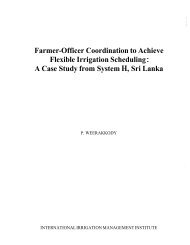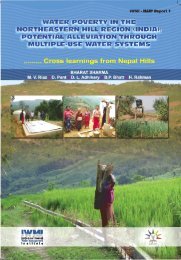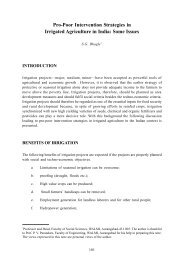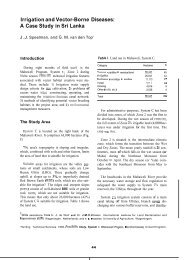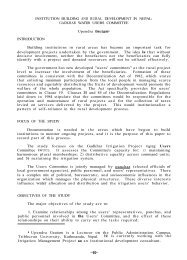The Impact of Small Scale Irrigation on Household Food Security ...
The Impact of Small Scale Irrigation on Household Food Security ...
The Impact of Small Scale Irrigation on Household Food Security ...
Create successful ePaper yourself
Turn your PDF publications into a flip-book with our unique Google optimized e-Paper software.
Irrigators have significantly more livestock thantheir rain-fed <strong>on</strong>ly farmers. <str<strong>on</strong>g>The</str<strong>on</strong>g>y also possessmore fertile land.Determinants <str<strong>on</strong>g>of</str<strong>on</strong>g> household food security: <str<strong>on</strong>g>The</str<strong>on</strong>g>significance <str<strong>on</strong>g>of</str<strong>on</strong>g> the lambda term in the sec<strong>on</strong>dstage <str<strong>on</strong>g>of</str<strong>on</strong>g> the Heckman procedure, c<strong>on</strong>firms thepresence <str<strong>on</strong>g>of</str<strong>on</strong>g> selectivity bias (Table 6). Asexpected, access to irrigati<strong>on</strong> had significantimpact <strong>on</strong> household food security. In the studyarea irrigati<strong>on</strong> enable households to grow cropsmore than <strong>on</strong>ce a year, to insure increased andstable producti<strong>on</strong>, income and c<strong>on</strong>sumpti<strong>on</strong>thereby improving food security status <str<strong>on</strong>g>of</str<strong>on</strong>g> thehousehold. This result is c<strong>on</strong>sistent with thefinding <str<strong>on</strong>g>of</str<strong>on</strong>g> Abebaw (2003). <str<strong>on</strong>g>The</str<strong>on</strong>g> other variablesthat significantly enhance household foodsecurity are experience (as indicate by farmersage in years), access to extensi<strong>on</strong> service, andsize <str<strong>on</strong>g>of</str<strong>on</strong>g> cultivated land. .<str<strong>on</strong>g>The</str<strong>on</strong>g> relati<strong>on</strong>ship between household size andfood security is n<strong>on</strong>-linear (see the coefficientsfor household size and its square variable). <str<strong>on</strong>g>The</str<strong>on</strong>g>negative and significant coefficient <str<strong>on</strong>g>of</str<strong>on</strong>g> householdsize reveals that larger household size leads t<str<strong>on</strong>g>of</str<strong>on</strong>g>ood insecurity, but <strong>on</strong>ly up to a certain point.<str<strong>on</strong>g>The</str<strong>on</strong>g> coefficient <str<strong>on</strong>g>of</str<strong>on</strong>g> the variable indicates that asthe household size increases by <strong>on</strong>e adultequivalent the food c<strong>on</strong>sumpti<strong>on</strong> expenditure <str<strong>on</strong>g>of</str<strong>on</strong>g>the household decreases by 391.9 Birr. Thisresult is c<strong>on</strong>sistent with the finding <str<strong>on</strong>g>of</str<strong>on</strong>g> Mulugeta(2002) and Yilma (2005). C<strong>on</strong>trary to othersimilar studies (Belayneh, 2005), in this studyfemale headed households had better foodsecurity status than the male headed households.<str<strong>on</strong>g>The</str<strong>on</strong>g> coefficient <str<strong>on</strong>g>of</str<strong>on</strong>g> the variable shows that whenthe head <str<strong>on</strong>g>of</str<strong>on</strong>g> the household is male, foodc<strong>on</strong>sumpti<strong>on</strong> expenditure <str<strong>on</strong>g>of</str<strong>on</strong>g> the householddecreases by 331.1 Birr. <str<strong>on</strong>g>The</str<strong>on</strong>g> possiblejustificati<strong>on</strong> for this inverse relati<strong>on</strong>ship couldbe that though male headed households are in abetter positi<strong>on</strong> to pool resource to increaseproducti<strong>on</strong>, they might spent more m<strong>on</strong>ey <strong>on</strong>n<strong>on</strong>food expenses rather than spending <strong>on</strong> fooditems to meet the household’s food needs.<str<strong>on</strong>g>The</str<strong>on</strong>g> regressi<strong>on</strong> result also shows that as thecultivated land size increases, a household isable to increase and diversify the quantity andtype <str<strong>on</strong>g>of</str<strong>on</strong>g> crop produced, which may in turn lead toincreased c<strong>on</strong>sumpti<strong>on</strong> and household foodsecurity. <str<strong>on</strong>g>The</str<strong>on</strong>g> coefficient <str<strong>on</strong>g>of</str<strong>on</strong>g> the land size variableshows that as the household gets <strong>on</strong>e morehectare <str<strong>on</strong>g>of</str<strong>on</strong>g> land food c<strong>on</strong>sumpti<strong>on</strong> expenditure <str<strong>on</strong>g>of</str<strong>on</strong>g>the household increases by 85 Birr. This result isc<strong>on</strong>sistent with the findings <str<strong>on</strong>g>of</str<strong>on</strong>g> Mulugeta (2002),Ayalew (2003), Abebaw (2003) and Yilma(2005).Access to extensi<strong>on</strong> service and nearness to thewater source are also found to have a positiverelati<strong>on</strong>ship with household food security. <str<strong>on</strong>g>The</str<strong>on</strong>g>positive effect <str<strong>on</strong>g>of</str<strong>on</strong>g> access to extensi<strong>on</strong> servicemay indicate that in the study area, thosehouseholds who get technical advice andtraining or those who participated in fielddem<strong>on</strong>strati<strong>on</strong>s are well aware <str<strong>on</strong>g>of</str<strong>on</strong>g> the advantage<str<strong>on</strong>g>of</str<strong>on</strong>g> agricultural technologies and adopt newtechnologies and produce more, therebyimproving the household food security status.<str<strong>on</strong>g>The</str<strong>on</strong>g> nearness to the water source may be asurrogate variable for access to irrigati<strong>on</strong>. It hasalready been shown that to the irrigati<strong>on</strong>scheme, significantly improves household’s foodsecurity status. <str<strong>on</strong>g>The</str<strong>on</strong>g> possible other justificati<strong>on</strong>could be that the nearness to water source mayproxy the locati<strong>on</strong> <str<strong>on</strong>g>of</str<strong>on</strong>g> the farms in relati<strong>on</strong> to theirrigati<strong>on</strong> water source . <str<strong>on</strong>g>The</str<strong>on</strong>g>refore, householdswho are closer to the irrigati<strong>on</strong> scheme do notincur much cost to access their farm so they canfollow up the farm activity closely andfrequently and may get a better yield.4. C<strong>on</strong>clusi<strong>on</strong> and Implicati<strong>on</strong>s<str<strong>on</strong>g>The</str<strong>on</strong>g> variables that significantly predict access toirrigati<strong>on</strong> are: household size, size <str<strong>on</strong>g>of</str<strong>on</strong>g> cultivatedland, livestock holding, farmers’ percepti<strong>on</strong> <str<strong>on</strong>g>of</str<strong>on</strong>g>soil fertility status, access to credit, nearness tothe water source and household size square. <str<strong>on</strong>g>The</str<strong>on</strong>g>variables that reduce the probability <str<strong>on</strong>g>of</str<strong>on</strong>g> access toirrigati<strong>on</strong> are large household size, largecultivated area and access to credit. Rain-fedfarmers tend to have large cultivated area. <str<strong>on</strong>g>The</str<strong>on</strong>g>negative relati<strong>on</strong>ship between access to creditand access to irrigati<strong>on</strong> may be explained by thefact that: (1) in Ethiopia, the instituti<strong>on</strong>al creditsusually give priority to rain-fed agriculture, and(2) the demand for credit am<strong>on</strong>g farmers withaccess to irrigati<strong>on</strong> may be lower for they cansatisfy cash needs through sales from theirirrigated crops.186



